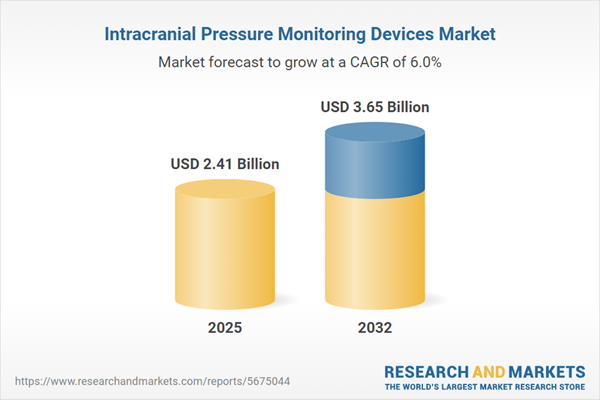Speak directly to the analyst to clarify any post sales queries you may have.
The intracranial pressure monitoring devices market is evolving rapidly as healthcare systems prioritize advanced technological solutions for improved neurological care. Executives seeking to strengthen patient outcomes and operational efficiency now face new complexities and opportunities.
Market Snapshot: Global Intracranial Pressure Monitoring Devices Market
The global intracranial pressure monitoring devices market is projected to expand from USD 2.28 billion in 2024 to USD 2.41 billion in 2025, and further reach USD 3.65 billion by 2032, reflecting a 6.04% compound annual growth rate. This expansion is driven by ongoing advancements in both invasive and noninvasive monitoring technologies. Precise and timely monitoring capabilities are supporting better clinical decision-making and increasing adoption of these solutions in both acute and outpatient settings. Manufacturers are focused on streamlining workflows and accelerating innovation, aiming to respond responsively to growing neurocritical care needs and operational challenges.
Scope & Segmentation Overview
This comprehensive research equips senior decision-makers with structured, actionable insight into the intracranial pressure monitoring devices market’s critical segments and technology trends, supporting confident executive planning and investment decisions.
- Technology Types: Fiber optic sensors, strain gauge systems, microtransducer devices, ocular sonography, and transcranial Doppler ultrasound expand diagnostic flexibility to match evolving clinical pathways and care environments.
- End Users: Facilities such as neurology clinics, ambulatory surgical centers, surgical suites, multi-specialty hospitals, research institutes, and clinical laboratories require adaptable workflows and specialized devices for neurocritical care management.
- Distribution Channels: Direct supply routes, original equipment manufacturer (OEM) agreements, e-commerce platforms, and value-added resellers contribute to a resilient, streamlined supply chain and broad device accessibility on a global scale.
- Applications: Monitoring devices play a key role in patient stratification and managing conditions such as intracranial hemorrhage, hydrocephalus, and traumatic brain injuries, enabling healthcare providers to allocate resources more effectively.
- Device Types: Epidural sensors, intraparenchymal probes, intraventricular catheters, subarachnoid sensors, and subdural sensors boost diagnostic precision and allow adaptation to a range of clinical protocols and operational settings.
- Regions Analyzed: The Americas, EMEA, and Asia-Pacific exhibit diverse regulatory standards, procurement approaches, and market trends, which significantly shape regional adoption and influence strategic positioning for suppliers and purchasers.
- Leading Companies: Key market participants include Integra LifeSciences Corporation, Medtronic plc, Sophysa SAS, Raumedic AG, Natus Medical Incorporated, ICU Medical, Inc., B. Braun Melsungen AG, Drägerwerk AG & Co. KGaA, Nihon Kohden Corporation, and Gaeltec Limited. Leadership is distinguished by ongoing research, product differentiation, and robust global market presence.
Key Takeaways for Senior Decision-Makers
- Miniaturization of monitoring platforms is widening access to neurological care, supporting clinical teams beyond major hospitals and facilitating remote patient management.
- Implementation of noninvasive monitoring solutions streamlines care delivery, enabling effective neurological assessments even in facilities with limited specialist resources and lowering procedural risks for patients.
- Prioritizing user-centric design and reinforcing risk management are essential to secure clinical confidence, drive adoption, and comply with changing regulatory expectations.
- Integration with electronic health records (EHRs) enhances real-time clinical data sharing, fostering team-based approaches and delivering improved clinical insights at critical decision points.
- Adaptive supply chain strategies, including diversified distribution, enable resilience as regulatory frameworks and procurement environments evolve globally.
- Balanced device portfolios that cater to both premium and value-driven needs elevate overall operational performance while supporting providers managing varied care models.
Tariff Impact: Navigating US Import Changes and Building Resilience
Impending changes to US import tariffs in 2025 are prompting manufacturers—particularly those producing fiber optic and microtransducer devices—to reassess global sourcing and supplier arrangements. To sustain stable device supply and regulatory compliance, companies are adopting nearshoring, strengthening regulatory engagement, and diversifying supplier partnerships. These measures support risk mitigation, transparency, and continuity of neurocritical care delivery during shifting tariff landscapes.
Methodology & Data Sources
Insights in this report are derived from in-depth interviews with neurosurgeons, biomedical engineers, and senior healthcare stakeholders. Supplementary sources include regulatory overviews, patent reviews, and clinical trial data, providing a multi-dimensional foundation for strategic planning and capital investment.
Why This Report Matters: Executive Value in the Intracranial Pressure Monitoring Devices Market
- Offers a clear framework for senior leadership to prioritize technology investments and drive innovation aligned with evolving risk management needs.
- Supports operational flexibility and compliance amid dynamic regulatory and technology transitions, ensuring sustained business continuity and competitive resilience.
- Guides management teams in optimizing workflows and integrating new technologies, equipping organizations to address complex patient and operational demands.
Conclusion
Forming compliant partnerships and adopting adaptable technologies are essential for advancing neurocritical care. Collaborative, agile strategies equip organizations to improve both patient outcomes and operational robustness.
Additional Product Information:
- Purchase of this report includes 1 year online access with quarterly updates.
- This report can be updated on request. Please contact our Customer Experience team using the Ask a Question widget on our website.
Table of Contents
3. Executive Summary
4. Market Overview
7. Cumulative Impact of Artificial Intelligence 2025
Companies Mentioned
The companies profiled in this Intracranial Pressure Monitoring Devices market report include:- Integra LifeSciences Corporation
- Medtronic plc
- Sophysa SAS
- Raumedic AG
- Natus Medical Incorporated
- ICU Medical, Inc.
- B. Braun Melsungen AG
- Drägerwerk AG & Co. KGaA
- Nihon Kohden Corporation
- Gaeltec Limited
Table Information
| Report Attribute | Details |
|---|---|
| No. of Pages | 196 |
| Published | October 2025 |
| Forecast Period | 2025 - 2032 |
| Estimated Market Value ( USD | $ 2.41 Billion |
| Forecasted Market Value ( USD | $ 3.65 Billion |
| Compound Annual Growth Rate | 6.0% |
| Regions Covered | Global |
| No. of Companies Mentioned | 11 |









